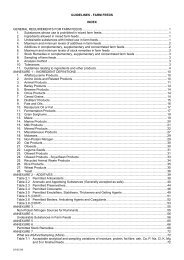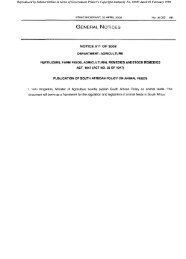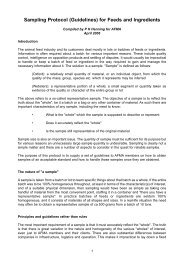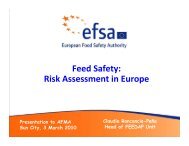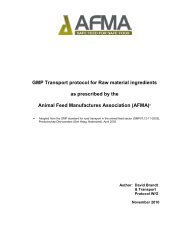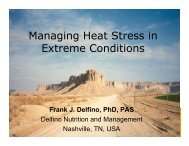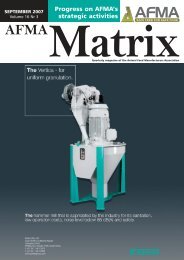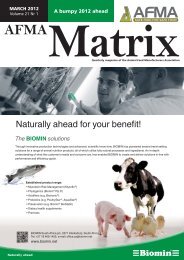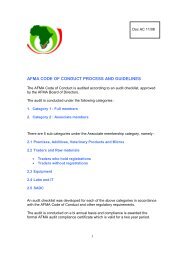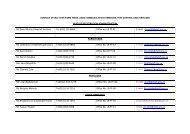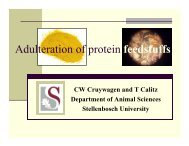Create successful ePaper yourself
Turn your PDF publications into a flip-book with our unique Google optimized e-Paper software.
enal osmotic malfunction and/or digesta<br />
viscosity in the GUT.<br />
Animals<br />
It is common knowledge that most genetic<br />
strains/lines within pigs and poultry are<br />
directly selected for enhanced feed efficiency<br />
(FE), as well as an improved protein<br />
deposition rate (PDR) and subsequently<br />
lean growth. This selection for improved<br />
FE might result in direct selection of a<br />
lower VFI due to the lower maintenance<br />
requirements of the genetically improved<br />
animals.<br />
VFI also depends on the age and production/reproduction<br />
stage of the animal<br />
due to the physical development of the<br />
GIT. Young rapidly growing broiler birds<br />
would most probably consume as much<br />
feed as physically possible, while laying<br />
hens will regulate their VFI according to<br />
their nutrient requirements in terms of<br />
egg output.<br />
Although chickens have fewer taste<br />
buds than pigs (300 versus 15 000) in their<br />
oral cavity, it doesn’t necessarily make<br />
them less selective when it comes to feed<br />
acceptability, and they have a well-developed<br />
feed perception method. Certain<br />
putative taste genes have been identified<br />
in chickens and their ability to select feed<br />
by means of sensory perception (particle<br />
size, colour, hardness/flexibility of pellets<br />
etc.), is well-known.<br />
A condition called “neophobia” could<br />
occur when the physical appearance in<br />
terms of size and colour of a diet suddenly<br />
changes, resulting in the refusal of feed.<br />
Feed ingredients may reduce palatability,<br />
while mycotoxins/moulds would result<br />
in a significant depression of VFI. Additionally,<br />
chickens prefer to eat “meal size”<br />
portions, which mean they will eat a “full<br />
meal” every hour if they are allowed to<br />
do so. However, with an increase in stocking<br />
density (>30kg/m 2 ) and growth rate,<br />
a subsequent increase in competition for<br />
space at feeder trays and drinker nipples<br />
develops, which negatively influences VFI.<br />
Some of the other animal factors that<br />
might influence the VFI of pigs and chickens,<br />
include social behaviour and dominance<br />
or pecking order, and the availability<br />
of “cage/pen” enrichment to reduce<br />
boredom and stimulate exercise.<br />
One aspect that is often neglected when<br />
it comes to predicting VFI during diet formulation,<br />
is the immune status of animals.<br />
The general health of animals could either<br />
render them incapable to obtain or ingest<br />
feed due to physical strength/fever, or the<br />
body’s own response to antigen formation<br />
would increase the maintenance requirements<br />
of the animal since nutrients<br />
(amino acids) and energy are diverted for<br />
this process. Therefore the general nutritional<br />
status of animals must be borne in<br />
mind when vaccinating animals, since a<br />
few hours’ response might result in a few<br />
grams lost within a 35-day growing period.<br />
Environmental constraints<br />
Environmental temperature (and relative<br />
humidity) is probably the most important<br />
environmental factor that influences VFI.<br />
An increase in temperature above the upper<br />
critical temperature (UCT) would decrease<br />
VFI, especially if the CF of the diet<br />
is high. This drop in VFI could partly be<br />
offset by an increase in nutrient density,<br />
but would only be a short-term method<br />
to enhance nutrient consumption.<br />
Also, the increase in feed price due to<br />
an increased nutrient density would most<br />
probably not warrant this practice for<br />
broilers in the current financial climate.<br />
Although cold temperatures would also<br />
result in a poorer FE, the magnitude might<br />
be less than that of hot temperatures.<br />
Lastly, cleanliness, wind draught and<br />
speed, floor isolation, NH 3<br />
gas, photoperiod,<br />
feeder and water line design could<br />
all play a less important role in the prediction<br />
of VFI for pigs and chickens. Years of<br />
experience in terms of animal husbandry<br />
and plenty of common sense will ensure<br />
that you develop a set of rules for a specific<br />
species and its specific nutrient requirements.<br />
Ruminants<br />
Chemostatic control<br />
Control of intake by effects of blood metabolytes<br />
on the appetite centre is known<br />
as chemostatic regulation of feed intake.<br />
An energy deficit is thought to generate<br />
hunger signals, the intensity which is<br />
directly related to the size of the deficit.<br />
The signals controlling feed intake at the<br />
metabolic level in ruminants are likely to<br />
be different from those in monogastric<br />
animals. Therefore it would seem unlikely<br />
that a glucostatic mechanism of intake<br />
control could apply to ruminants.<br />
A more likely mechanism might involve<br />
the volatile fatty acids (VFA) absorbed<br />
from the rumen. Intra-ruminal infusions<br />
of acetate and propionate have been<br />
shown to depress VFI of concentrate diets<br />
for ruminants. These same infusions into<br />
the hepatic portal vein may also reduce<br />
intake via signals send by the liver to the<br />
hypothalamus.<br />
Butyrate seems to have less of an<br />
effect on feed intake than acetate and<br />
propionate. With diets consisting mainly<br />
of roughages, infusions of VFAs have had<br />
less of a definite effect on VFI.<br />
Effect of food characteristics<br />
Ruminants are adapted to utilise “bulky”<br />
feeds, hence fibrous foods have remain in<br />
the digestive tract longer in order for their<br />
digestible components to be extracted. If<br />
foods are detained in the digestive tract,<br />
the animal’s throughput (daily intake)<br />
will be reduced. It is postulated that the<br />
digesta load generates satiety signals, the<br />
intensity of which is directly related to the<br />
size of the load beyond a threshold value.<br />
It has long been recognised that in<br />
ruminants there is a positive relationship<br />
between the digestibility of foods (resistance<br />
to degradation) and their intake. In<br />
previous experiments it was found that<br />
dietary intake of lambs more than doubled<br />
as the energy digestibility of the food<br />
(hay source) increased from 0,4 to 0,8.<br />
When supplementing a roughage<br />
source with concentrates, the concentrate<br />
added to a roughage source of low<br />
digestibility tends to be eaten in addition<br />
to the roughage, but when added to<br />
roughage of high digestibility it tends<br />
to replace the roughage. Therefore food<br />
that is digested rapidly, and is also highly<br />
digestible, promotes high intakes.<br />
Neutral-detergent fibre (NDF) is in this<br />
regard the primary chemical component<br />
of foods that determines their rate of<br />
Processing<br />
<strong>AFMA</strong> MATRIX ● APRIL <strong>2013</strong> 31



